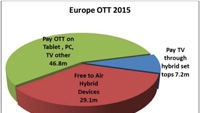European OTT rush lacks direction

Europe was quick off the mark with online Free To Air catch up services, but the rush to OTT in the pay TV industry is only just getting underway. It is set to take off now though, with 83 million devices accessing OTT content by 2015, compared with 15.7 million at the end of 2011, according to the report from UK based analysis and market research group Rethink TV. Called Navigating OTT: Over The Top Video Markets in Europe Report and Forecast 2011 to 2015, the report does not count existing free to air catch up services consumed mostly on PCs and tablet devices in its predicted 2015 figure, because the number of these is much greater and would distort the overall picture of rapid OTT growth from now on. It is true though that current or emerging services from the leading broadcasters and pay TV operators will dominate in the OTT market, with opportunities for new players restricted to general purpose devices.
One of the report’s main findings is confusion and divergence among European pay TV operators and broadcasters over how to bring OTT to market and make money out of it. Partly for this reason, growth in dedicated hybrid set top boxes, like the Horizon box being promoted by Liberty Global in a number of European markets including the Netherlands and Germany, will be disappointing. This will be reflected in relatively slow growth in such top end hybrids over the forecast period, accounting for 800,000 of the 15.7 million OTT connected devices in 2011, rising to 7.2 million of the total 83 million in 2015.
Such high-end hybrids, provided by a pay TV operator to existing subscribers, either for an extra fee or as part of a premium package, constitute one of three OTT service categories identified by the Rethink TV report. The other two are pure-paid OTT and Free To Air hybrid services. Pure-paid OTT services usually involve a pay TV operator providing access to existing services from Internet connected devices such as PCs, tablets, smart phones and smart TVs, an example being the Sky Go service in the UK. But this category also includes dedicated OTT services from new providers, or from existing operators not requiring a contract to the traditional, walled, garden broadcast package. This will be the biggest sector according to the report, growing from 12.4 million devices in 2011 to 46.8 million in 2015.
The report points out that the number of potential OTT devices sold is much greater than the number actually connected to services, which in turn may be more than the number of homes where such devices are owned. First, many devices are not connected, so that in Germany over two million HbbTV capable devices have already been shipped, but only around 600,000 of these were connected to services during 2011. Then some homes will have more than one OTT connected device — on average between one and two — so the total number of OTT homes will be less than the total number of connected devices.
The Rethink OTT Europe Report and Forecast has a complete breakdown for each of the top 20 countries across these three sectors, plus predictions for all the major operators, as well as detailed analysis of the situation in each of these countries in turn.
Get the TV Tech Newsletter
The professional video industry's #1 source for news, trends and product and tech information. Sign up below.
